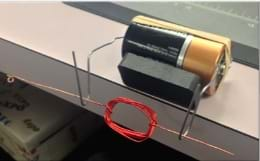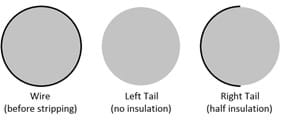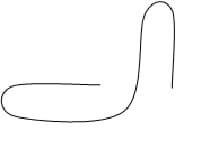Quick Look
Grade Level: Elementary school
Time Required: 1 hour
Expendable Cost: US $3.00
Group Size: 3
Subject Areas: Physical Science, Physics
Introduction
Bolded words are vocabulary and concepts to highlight with students during the activity.
What is a motor? A motor is a device that converts electrical energy into kinetic energy. Basically, motors receive electrical energy from an electricity source, such as an outlet or battery, and convert that energy into mechanical energy, causing something to spin, move or do some form of work. Today, students use two types of magnets to create such a motor: an electromagnet and a permanent magnet. Students are probably familiar with a permanent magnet—it is the type that sticks to refrigerator doors. It is called a permanent magnet because it always has a magnetic field. An electromagnet is different because its magnetic field is created by an electric current, meaning the magnetic field can be removed by turning off the electricity. 
Supplies
Each group needs:
- wire cutters
- 12" (30 cm) piece of thread
- 2" x 2" (5 cm x 5 cm) piece of 150-grit sandpaper
- 3 large paperclips
- 1 wide rubber band
- 30" (76 cm) of 22 gauge insulated magnet wire
- 1 D-cell battery
- 1 rectangular magnet
- blank paper
Subscribe
Get the inside scoop on all things TeachEngineering such as new site features, curriculum updates, video releases, and more by signing up for our newsletter!Procedure
Procedures Overview
Working in groups of three, students make motors that consist of three parts: a permanent magnet, an electromagnet (a coil of wire), and a battery. The wire is made of copper, and is therefore not magnetic. But, when current is run through the wire coil, it generates a magnetic field, allowing it to act as a magnet. Its magnetic poles want to align with the poles of the permanent magnet, making it turn. Together, the battery, magnet and electromagnet (wire) act as a motor by converting electric energy from the battery to mechanical energy, evidenced by the spinning motion of the wire coil. Half of the insulation is removed from one wire end, so that when it turns and the insulation comes in contact with the battery (through the paperclip), there is no current and therefore no magnetic field. This occurs at the point in which the poles of the electromagnet would align with the magnet's poles. If there was still current running, the attraction of the magnetic poles would cause the electromagnet (wire coil) to stop moving. But instead, without the force of magnetic attraction, the inertia of the rotating coil helps keeps the coil turning, and brings the un-insulated portion of the wire back in contact with the battery, completing the circuit, re-introducing the electric current through the wire and the electromagnetic poles, causing the coil to continue rotating. This engine can be used to do work...such as lift a paperclip!
Making the Components
Note: Perform all of the steps along with the students as a class demonstration.
- Hand out the supplies to students.

Figure 2. The wire coil. - Starting 1.5" (3.8 cm) from the end, wrap the wire around the short side of the magnet 7 times leaving both "tails" on opposite sides of the magnet.
- Gently slide the wire off the magnet, keeping the rectangular shape.
- Leave 3" (7.6 cm) of extra wire on the second tail (this is the "long" tail), and cut off any extra wire (see Figure 2).
- Wrap each tail around its side of the coil so that it is bound together; make sure to smooth out each tail so that they make flat lines (see Figure 2).
- Sanding the wire tails (note: help students with these steps—if done incorrectly, the motor will not work; see Figure 3): Use the sandpaper to gently remove all the insulation from the long tail, starting at the top and going up to ¼" (0.6 cm) from the coil. Lay the short tail down on a sheet of paper and use the sandpaper to gently remove the insulation from the top half of the wire only.

Figure 3. Sanding the wire. - Unfold two of the paperclips so that they look like the one in Figure 4.
- Lightly sand all of the paperclip surfaces.
Putting It All Together
- Use a rubber band to secure the loops of the paperclip to each terminal of the battery (see Figure 1).

Figuare 4. Unfolding the paperclip. - Make sure the small loops of the paperclip are on the same side of the battery and make sure they are level.
- Stick the magnet to the battery between the small loops of the paperclips, as shown in Figure 1; do not let the paperclips touch the magnet.
- Put the battery on a table with the small loops hanging off the edge (see Figure 1); make sure the coil will not bump the table.
- Rest the wire coil in the small loops (see Figure 1), again making sure it is level.
- Give the wire coil a push, and watch it spin! Review with students how the motor works.
Doing Some Work
- Tie the thread to the last paperclip.
- Gently make a small loop at the very end of the long tail of the wire.
- Tie the other end of the thread to the loop.
- Put the wire coil back on the small loops and try to get your engine to lift your paperclip. It may take a few tries, but it will work.
Hints
- Make sure the wire is clean where it touches the paperclips (it gets dirty over time).
- Try adjusting the distance between the magnet and the wire and between the small paperclip loops.
- Be sure to remove all magnets from batteries; otherwise the batteries will drain.
Wrap Up - Thought Questions
- What are some factors that made the motor go faster or slower? Why?
- Why does the motor need a push to get it started?
- What would have happened if we had taken all of the insulation off of both ends of the wire?
- What would happen if we increased or decreased the number of coils in the electromagnet?
More Curriculum Like This

Students learn more about magnetism, and how magnetism and electricity are related in electromagnets. They learn the fundamentals about how simple electric motors and electromagnets work. Students also learn about hybrid gasoline-electric cars and their advantages over conventional gasoline-only-pow...

Students investigate motors and electromagnets as they construct their own simple electric motors using batteries, magnets, paperclips and wire.

Students are briefly introduced to Maxwell's equations and their significance to phenomena associated with electricity and magnetism. Basic concepts such as current, electricity and field lines are covered and reinforced. Through multiple topics and activities, students see how electricity and magne...
Copyright
© 2013 by Regents of the University of ColoradoLast modified: May 12, 2022






User Comments & Tips